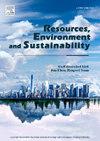Guiding cultivar choice in smallholder agriculture: Identifying suitability hotspots for maturity groups of field crops
IF 12.4
Q1 ENVIRONMENTAL SCIENCES
引用次数: 0
Abstract
The adoption of suitable crop cultivars is central to the sustainable intensification of smallholder cropping systems across Sub-Saharan Africa and plays a crucial role in improving smallholder incomes and food security. Breeding programmes have significantly increased the availability of early-, mid-, and late-maturing crop cultivars tailored to the Target Population of Environments in Sub-Saharan Africa. However, there is a substantial lack of data-driven maturity group recommendations at a detailed spatial scale. The absence of targeted guidance on the suitability of maturity groups limits the ability of smallholder farmers to make optimal cultivar adoption decisions. Here, we propose a framework using gridded crop modelling to identify locally relevant maturity group recommendations at a high spatial resolution for field crops. Implementing the framework for maize in Ghana, we employ the APSIM crop model across 3927 point locations and weather records for recent thirty years. We show that mid-maturing cultivars consistently provide the highest yields across all national production locations in the major growing season. In the minor growing season, we find that early- and mid-maturing cultivars provide the highest yields across distinct spatial suitability clusters. Specifically, in the minor growing season, mid-maturing cultivars provide the highest yields in high-yielding environments, while early-maturing varieties provide the highest yields in low-yielding environments. We identify specific environment-by-management combinations for which different maturity groups are optimal. The proposed framework enables the development of spatially and seasonally tailored maturity group recommendations that take advantage of prevailing genotype-by-environment-by-management interactions. The approach can readily be scaled to other crops and countries.

指导小农农业的栽培品种选择:确定大田作物成熟度组的适宜性热点
采用合适的作物品种是撒哈拉以南非洲地区小农种植制度可持续集约化的核心,在提高小农收入和粮食安全方面发挥着至关重要的作用。育种计划大大增加了针对撒哈拉以南非洲环境目标群体量身定制的早、中、晚熟作物品种的可得性。然而,在详细的空间尺度上,大量缺乏数据驱动的成熟度组建议。缺乏关于成熟度群体适宜性的有针对性的指导,限制了小农做出最佳品种采用决策的能力。在这里,我们提出了一个使用网格作物模型的框架,以高空间分辨率为大田作物确定当地相关的成熟度组建议。为了在加纳实施玉米框架,我们在3927个地点和近30年的天气记录中采用了APSIM作物模型。我们表明,在主要生长季节,在所有国家生产地点,中成熟品种始终提供最高的产量。在小生长期,在不同的空间适宜性集群中,早熟和早熟品种的产量最高。具体而言,在小生长期,中熟品种在高产环境下产量最高,而早熟品种在低产环境下产量最高。我们确定了特定的环境管理组合,不同的成熟度组是最优的。所提出的框架能够利用普遍存在的基因型-环境-管理相互作用,制定适合空间和季节的成熟度组建议。这种方法可以很容易地推广到其他作物和国家。
本文章由计算机程序翻译,如有差异,请以英文原文为准。
求助全文
约1分钟内获得全文
求助全文
来源期刊

Resources Environment and Sustainability
Environmental Science-Environmental Science (miscellaneous)
CiteScore
15.10
自引率
0.00%
发文量
41
审稿时长
33 days
 求助内容:
求助内容: 应助结果提醒方式:
应助结果提醒方式:


